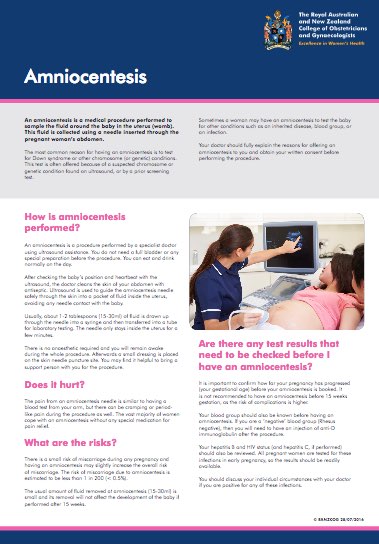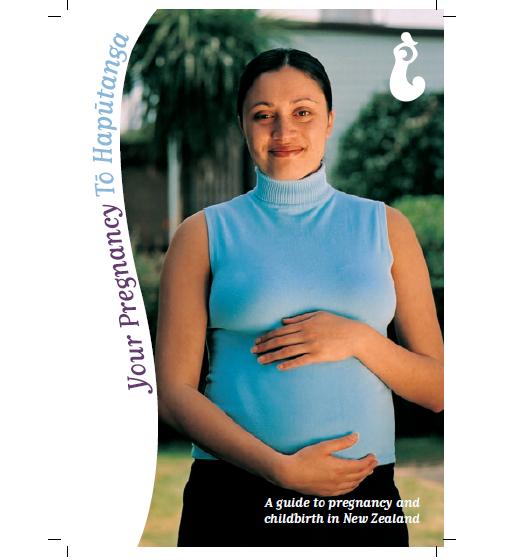Scam alert: Ads or websites claiming to have Medsafe approval or with the Medsafe logo are fake. Medsafe doesn’t endorse any health products, services or brands. Go to Medsafe for official information.
Amniocentesis
Key points about amniocentesis
- Amniocentesis is a procedure during pregnancy where a small amount of the fluid (known as amniotic fluid) surrounding the foetus is taken by needle from the womb (uterus) under ultrasound guidance.
- The purpose of amniocentesis is to examine the amniotic fluid to check if your baby may have:
- a genetic (inherited) condition such as Down syndrome or a blood condition such as sickle cell anaemia
- a medial condition affecting the brain or spinal cord, eg, spina bifida.
- The results will also determine the sex of your baby.

An amniocentesis is a procedure carried out when you're hapū (pregnant) to see if your baby may have a genetic (inherited) condition.
It involves taking a small sample of amniotic fluid (the fluid surrounding the fetus) from the womb. It's removed with a needle guided by ultrasound.
Conditions it can be used to check for include:
- Down syndrome
- a blood condition such as sickle cell anaemia
- a medical condition affecting the brain or spinal cord, eg, spina bifida.
The results will also find out the sex of your baby.
When needed, an amniocentesis is usually performed around the 15th week of pregnancy. However, if there isn’t enough fluid at that time, it could be put off for a week or two.
The test can be recommended by your healthcare provider if you:
- have had an abnormal ultrasound, or maternal serum screening test with a result suggesting there is a higher risk of your baby having a genetic condition
- have a family history of certain genetic conditions, eg, cystic fibrosis
- have already had a child/pregnancy with a genetic condition
- are aged 35 years or over when your baby is due.
You don’t need to change the way you eat or drink before the procedure. You might want to arrange for somebody to drive you home afterwards in case you have any discomfort.
You will be able to have a partner or support person with you before and throughout the procedure. You will have an ultrasound scan so the doctor doing the amniocentesis can see where your baby is positioned and find the safest place to take a sample of amniotic fluid.
You may have the area numbed with local anaesthetic before a thin needle is inserted through the wall of your uterus into the sac containing the amniotic fluid surrounding your baby. A small amount of fluid (about 30mls) is removed. Your baby will be checked afterwards to make sure all is well.
The procedure should be no more painful than having a blood test, but there may be some discomfort afterwards.
Take it easy for a day or so and get some rest. If you have any bleeding or fluid loss through your vagina, let your healthcare provider know and rest in bed until the problem resolves. There may be some soreness where the needle went in.
Contact your healthcare provider urgently if you experience any of these:
- Bleeding or loss of fluid through your vagina.
- Severe cramping lasting more than a few hours.
- A fever (temperature higher than 38º C).
- Redness where the needle went in.
Amniocentesis is a relatively safe procedure but there are some risks:
- Leaking amniotic fluid: Rarely, a small amount of fluid can leak out through the vagina after the procedure. In most cases it will stop within a week and won’t affect your pregnancy.
- Needle injury: The baby might move an arm or leg into the path of the needle, but serious injury is rare.
- Rhesus sensitization (making antibodies against your baby’s blood cells): It is rare, but possible, for some of the baby’s blood cells to enter the mother’s bloodstream. This is only a problem if the mother’s blood group is Rhesus negative. If this is the case, you will be given an injection to stop your body making antibodies against your baby’s blood cells.
- Miscarriage: There is a slight increased risk of miscarriage (losing the baby) after an amniocentesis. It’s hard to calculate the risk as miscarriage is not uncommon at this stage of the pregnancy anyway. However, the risk is estimated to be about 1 to 3 cases in 1000 people (0.1–0.3%). The risk may be higher if the amniocentesis is done during the first trimester (first 3 months of pregnancy).
It can take a couple of weeks for the results to be ready. The results will be sent to your healthcare provider who will discuss them with you.
Amniocentesis – a patient's guide(external link) Family Doctor, NZ
Apps
References
- Amniocentesis(external link) Mayo Clinic, US, 2022
- Amniocentesis – a patient’s guide(external link) Family Doctor, NZ
- Pregnancy tests amniocentesis(external link) Better Health, Australia
- Amniocentesis(external link) NHS, UK
Technique modifications for reducing the risks from amniocentesis or chorionic villus sampling(external link) Cochrane Pregnancy and Childbirth Group, 2012
Antenatal screening for Down syndrome and other conditions(external link) National Screening Unit, NZ
See our page Ultrasound for healthcare providers
Apps
Brochures

RANZCOG, NZ, 2021

HealthEd, NZ, 2020
Credits: Healthify editorial team. Healthify is brought to you by Health Navigator Charitable Trust.
Last reviewed:
Page last updated:





